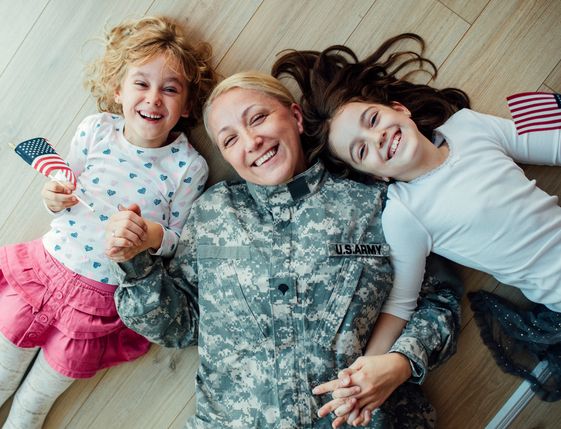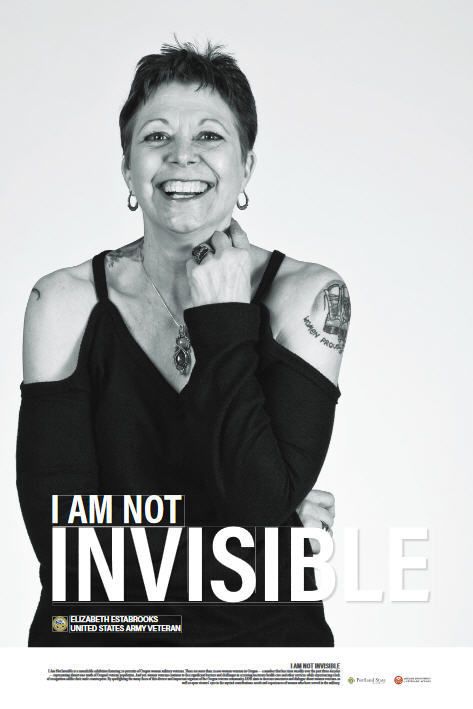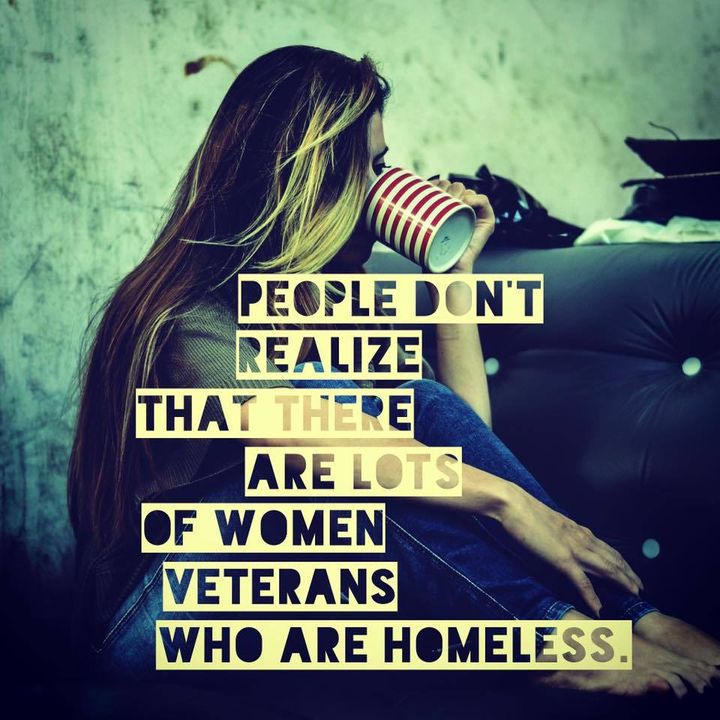
Women veterans, including women veterans with children, are the fastest growing group of homeless veterans today.
There are more than two million women veterans in the U.S. today, and women veterans who are homeless are the fastest-growing group of veteran homeless. Yet if you ask the average American — even the average veteran — to describe a homeless veteran, you’ll quickly hear an almost universal description. The picture most of us seem to carry in our minds is of a grizzled older white male who served in Vietnam, has chronic mental health and/or substance abuse issues, and can be seen panhandling at an intersection with a cardboard sign. The trouble with that picture, besides the fact that it’s become a cliché, is anyone who doesn’t present that way — specifically, women veterans who are homeless — are increasingly left out of the picture.
Ask women veterans who’ve experienced homelessness if they sense that they’re invisible, and they’ll tell you “yes,” but add that the problem didn’t start when they became homeless — it began when they first served in the military.
“When I came home from Iraq, I felt invisible as a woman vet,” says Kayla Williams, Army veteran, author, and current Director of the U.S. Department of Veterans Affairs’ (VA) Center for Women Veterans, in a clip from C-SPAN. She describes how she would go out with groups of other veterans to a bar, and someone would buy just ‘the guys’ a round of free beers, figuring that they’d just come back from the war but that the women in the group must be “just wives, girlfriends or other hangers-on.” “No one looks at me and thinks, ‘combat veteran,’” adds Williams.

Oregon state Women Veterans Coordinator Elizabeth Ann Estabrooks, Army veteran. From the “I Am Not Invisible” project.
The phenomenon of “discounting” exists when we look past a population because we don’t actually “see” them — whether women veterans in general, or homeless women veterans in particular. Columbia anthropologist and public scholar Kim Hopper, Ph.D., author of the seminal work, Reckoning with Homelessness, raised that issue in the American Journal of Public Health in connection with the volunteer counts of street homeless, a big part of how the total number of homeless, veterans and otherwise, in the U.S. is estimated.
“Especially difficult and extensive were ingrained dispositions that led counters to not see certain people as homeless, a phenomenon we labeled ‘discounting.’”
“Women veterans are invisible in so many ways,” says Oregon state Women Veterans Coordinator Elizabeth Ann Estabrooks, who also served in the Army. She says it’s a much thornier problem than whether we remember to use inclusive pronouns, or invite women veterans to take part in ceremonies. “If we want to help ‘veterans,’” she says, “We must begin to be intentionally inclusive of women veterans from the beginning, and always.” (There’s a great audio clip of Estabrooks talking about her experience in the Army, here.)
“Anytime there’s a conversation about veterans, women always seem to be an afterthought,” says Rosie Palfy, former Marine who served as a combat correspondent in the Gulf War era. “Stereotypes of who a veteran is” contribute to that problem, says Palfy. “People overlook women veterans,” she adds, “whether it’s their contributions to the military, or their unique needs, or the care and services they require.”

Comment from a woman veteran, as part of an ongoing survey on housing issues after military service.
Rebecca Fothergill-Murch would agree. She’s a Navy veteran who serves as the executive director of the Seattle Stand-Down, a volunteer-driven event that serves homeless veterans both male and female. “What’s the first thing that comes to the general public’s mind when they think of a military veteran?” she asks. “They think of Rambo, and heroes of war movies, and tough, strong men.” You could ask them, “You mean, you don’t think of a woman also as a veteran?” And they will stammer and admit, “Oh, no. I didn’t think that — not until you mentioned it.”
When Tracy Everbach, Ph.D., thinks about this phenomenon, the phrase that comes to mind is “symbolic annihilation.” “It sounds like a fancy term,” admits Everbach, who teaches journalism and mass communications at the University of North Texas at Denton, but what it means is that “if a group is not well-represented in the media,” and by media she means Hollywood and pop culture portrayals as well as the more traditional press, members of that group can find themselves “invisible or marginalized or trivialized.”

Humorous depiction of amount known about male vs. female veteran homelessness.
More than 25 years ago, a Los Angeles Superior Court judge, writing in a formal opinion, described the ‘credible testimony’ that homeless shared so many characteristics in common that they could be considered ‘badges’ that would readily identify them, according to Kim Hopper. Whether that concept sounds more convenient or absurd is up for interpretation, but it proves absolutely useless when we think about women veterans as part of the homeless population. They simply do not, and will not, present in ways that make them readily identifiable as homeless.
Civilians, veterans, even other women veterans often fail to realize that homeless women veterans are out there. “Wow! I guess I fall under the ‘ignorant’ category,” wrote one astonished female Marine veteran after my series on homeless women veterans first came out. “I didn’t fully grasp that there were so many homeless female vets. This article was a real eye-opener.”
Part of the way we can better understand who women veterans are and what they struggle with is to do more and better research into what makes them different from male veterans who become homeless. I sometimes joke that a modified “pie chart” (illustration above) is a good depiction of the comparative amount of research that’s been done to date into male and female veteran homelessness, respectively. In the absence of much research into the causes of female veteran homelessness or even accurate depictions of who homeless women veterans are, we’ve been left with attempting to squish women veterans into the prevailing male model, and they simply don’t fit.
When she started speaking out about her own experiences with homelessness, “I already knew that people who look like me, their stories were not being heard,” says BriGette McCoy, an Army veteran and military sexual trauma (MST) survivor who founded Women Veteran Social Justice Network, an advocacy group for veterans. “That made me stay in the game a little longer, to help advocate (for others).”
Are women veterans who become homeless more like their male veteran counterparts — or more like their civilian female counterparts? When and how do they first start struggling with precarious housing and homelessness — is it the same for both genders, or are there substantial differences? How about differences by branch, by length of service, by part of the country where the woman veteran is living when they first start to struggle? What about differences in terms of urban versus rural locations? Or by parenting status? According to one journal article comparing gender differences in homeless veterans:
“Several researchers have pointed out that the population of homeless women is heterogeneous and that homeless single women without children have different characteristics than homeless women with children.”
We seem to be at the beginning, not the middle or the end, of what’s known about women veterans who become homeless, if we’re willing to break away from the outdated model that they’re “just like male veterans who do,” and seek to understand them as a separate population with their own unique needs, desires, strengths and challenges. I hope if you’ve been reading the series on women veterans and homelessness, you’ve come to see their courage as well as the struggles they’ve overcome, and above all come to appreciate how very “normal” these women veterans seem. They could be, and in fact are, just like us. If we somehow manage to change the prevailing narrative about who homeless veterans are by including portraits of strong, capable women who have endured difficulties and yet can manage to overcome with the right, well-timed assistance, we will have done a lot.

Women veterans, please take and share this brief, IRB-approved online survey about housing issues after military service.
In the meantime, if you are a woman who served in the U.S. military, or a woman currently serving in the reserves, or a transgender veteran who served as a woman, please add to the knowledge base by taking this brief, IRB-approved survey while it stays open. More than 2,000 women veterans already have, making this the largest, non-VA survey of its kind. Sharing the link with others on social media or through email is also appreciated. If each woman veteran shared the survey with even three of her women veteran “sisters,” imagine how many more voices could be heard. Also, if you’re an advocate, please share the survey with women veterans and women reservists in your social networks, online and off. We want every woman veteran who would like to participate to have a chance to be represented in the research.
###
NOTE: This article is an addendum to the series entitled Coming Out of the Shadows: Women Veterans and Homelessness. The reporting for the series was conducted under a Howard G. Buffett inaugural grant from the International Women’s Media Foundation. The articles include “G.I. Jane Needs a Place to Sleep,” “Into the Gap: Women Veterans Describe Homelessness,” “Camaraderie Offsets Trauma for Women Veterans,” and “The Path Home for Women Veterans.” There are also two additional stories that capture further aspects of the topic: “Homeless Women Veterans Struggle to Be Seen” and “Down for the Count: Women Veterans Likely Underestimated in Federal Homelessness Figures.” There is also an interactive timeline of how we got to this point, a radio show/podcast featuring Lily Casura, BriGette McCoy and Rosie Palfy talking about female veteran homelessness, and a data visualization showing the comments of 400 women veterans describing their experiences of unstable housing after military service. Finally, there’s a website of state-specific housing resources for women veterans at risk for homelessness, where you can recommend additional resources.
